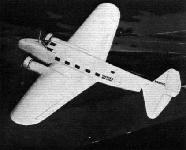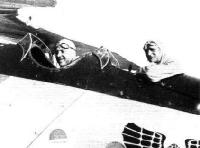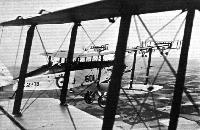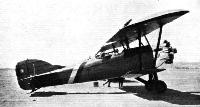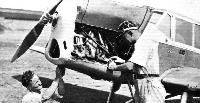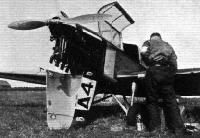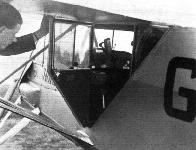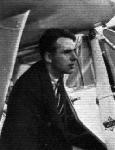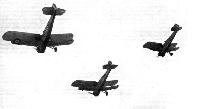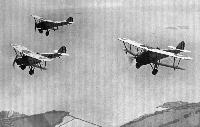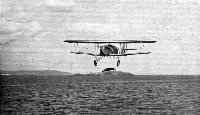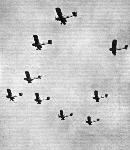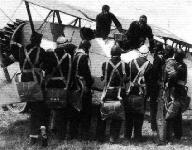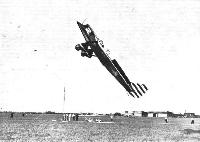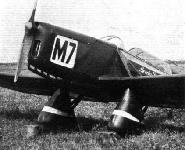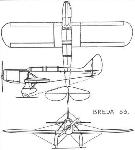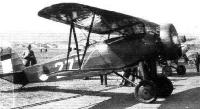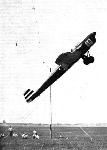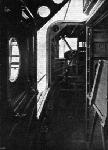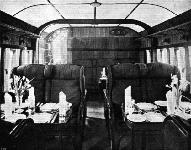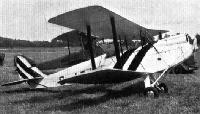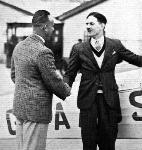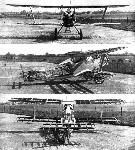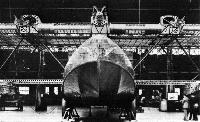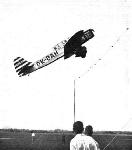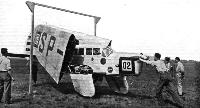Фотографии
-
A WINNER IN THE COMMERCIAL CLASS: The Junkers Ju. 52 3-m., with three "Hornet" engines of 525 h.p. each, manufactured by the B.M.W. Company.
Самолёты на фотографии: Junkers Ju.52/3m - Германия - 1931
-
A REMARKABLE CRASH: The damage to a Junkers Ju 52/3 m. caused by a mid-air collision with a "Flamingo" light plane. The Junkers managed to land safely without injury to passengers or crew.
Самолёты на фотографии: Junkers Ju.52/3m - Германия - 1931
-
SECOND IN THE SINGLE-SEATER CLASS: The Polish P.L.Z.11 (Bristol "Mercury 4") averaged 193 m.p.h.
Самолёты на фотографии: PZL P.11 - Польша - 1931
-
Регистрационный номер: SP-AHL [2] THE HIGH JUMP: Karpinski, on one of the Polish RWD machines, nearly succeeds in getting his "Genet Major" engine to lift him vertically over the tape, which is caught on the "spats."
Самолёты на фотографии: RWD RWD-6 / RWD-9 / RWD-20 - Польша - 1932
-
Регистрационный номер: F-ALLY, F-ALMA, F-ALXB, F-ALXV, F-AMBD [2], F-AMBM [2], F-AMBN [2], OK-BAH [2], OK-BEH, OK-WAL SOME OF THE FOREIGN COMPETITORS: In the foreground the French machines, Guerchais, Potez, Farman and Caudron.
in a middle background - Polish team, with PZL.19 and RWD-6 aircraftСамолёты на фотографии: Breda Ba.15 - Италия - 1928Breda Ba.33 / Ba.39 / Ba.42 - Италия - 1931Caudron C.230 / C.270 / Luciole - Франция - 1930Farman F.230 / F.350 - Франция - 1930Guerchais T.9 - Франция - 1930Mauboussin Corsaire / M-120 - Франция - 1932Potez Potez 43 / 58 - Франция - 1932Praga BH-111 - Чехословакия - 1932PZL PZL.19 - Польша - 1932RWD RWD-6 / RWD-9 / RWD-20 - Польша - 1932
-
Регистрационный номер: SP-AHI, SP-AHK, SP-AHL [2], SP-AHN BEETLES AT BERLIN: The Polish competitors, fitted with De Havilland "Gipsy III" and Armstrong Siddeley "Genet Major" engines.
RWD-9 - SP-AHL, SP-AHN; PZL-19 - SP-AHI, SP-AHKСамолёты на фотографии: PZL PZL.19 - Польша - 1932RWD RWD-6 / RWD-9 / RWD-20 - Польша - 1932
-
A U.S. NAVY SHIP'S FIGHTER: This Boeing "Wasp"powered carrier fighter of the Navy's Air Service is shown taking off from the flight deck of the U.S.S. "Saratoga," naval aeroplane carrier. The plane is a member of the Navy's famed "High Hat" Squadron, whose pilots are noted for their skill in taking off from and landing on the decks of the "floating airports" and in manoeuvring their small Boeing "Wasp"-powered fighters in formation at sea.
Самолёты на фотографии: Boeing F4B / P-12 - США - 1928
-
The new Boeing Air Transport, an all-metal low-wing monoplane fitted with two 550-h.p. "Wasp" engines.
Самолёты на фотографии: Boeing Model 247 - США - 1933
-
IN HOME AIRS: Swiss Dewoitines "formating" over Dubendorf.
Самолёты на фотографии: Dewoitine D.26 / D.27 / D.53 - Франция - 1928
-
AT THE DEAUVILLE MEETING: 2. Marcel Doret's "Dewoitine" (Hispano).
Самолёты на фотографии: Dewoitine D.26 / D.27 / D.53 - Франция - 1928
-
WINNER IN THE SINGLE-SEATER CLASS: The Hawker "Fury" (Rolls-Royce "Kestrel") and its pilot, Capt. Sintic, of the Yugoslav Air Force. The "Fury" won the race at an average speed of 201 m.p.h.
Самолёты на фотографии: Hawker Fury - Великобритания - 1931
-
WINNER OF THE RACE FOR TWO-SEATER MILITARY AIRCRAFT: The Fairey "Fox" (Rolls-Royce "Kestrel") of the Belgian Air Force, which did the "Circuit of the Alps" at an average speed of 160 m.p.h.
Самолёты на фотографии: Fairey Fox - Великобритания - 1925
-
THE PILOT OF THE "FOX": Capt. Van der Linden, of the Belgian Air Force, and His Passenger.
Самолёты на фотографии: Fairey Fox - Великобритания - 1925
-
SOMETHING IN THE CITY: Three Westland "Wapitis" (Jupiter) of No. 600 (City of London) (Bomber) Squadron on their way from Tangmere to Manston.
Самолёты на фотографии: Westland Wapiti - Великобритания - 1927
-
Регистрационный номер: K1146, K1156, K1157 THREE "WAPITIS": A Flight of No. 605 (County of Warwick) (Bomber) Squadron over Manston. Last year the Prince of Wales visited this squadron and presented the Esher Trophy to them, and they are said to be hot favourites for the Trophy again this year.
Самолёты на фотографии: Westland Wapiti - Великобритания - 1927
-
THE TROPHY-HOLDERS: No. 605 (County of Warwick) (Bomber) Squadron holds the Esher Trophy for the third time. It is encamped at Manston and is here shown flying over Thanet. The machines are "Wapitis."
Самолёты на фотографии: Westland Wapiti - Великобритания - 1927
-
No.1 AIR DEFENCE GROUP: The concentration of six squadrons of the Group at Manston on Friday, August 5. Misty weather prevented some squadrons from arriving in full strength. The squadrons are Nos. 501, 504, 600, 601, 604, and 605. All fly "Wapitis" except No. 504, whose "Horsleys" are drawn up in two lines in the rear.
Самолёты на фотографии: Hawker Horsley / Dantorp - Великобритания - 1925Westland Wapiti - Великобритания - 1927
-
Регистрационный номер: K2238 AIR WORK UNLIMITED: Sqd. Ldr. Nigel Norman leads No. 601 (County of London) (Bomber) Squadron from Lympne to the Manston concentration. Intelligent readers will recognise the machines.
Самолёты на фотографии: Westland Wapiti - Великобритания - 1927
-
PORTUGUESE-BUILT: A Potez XXV with "Jupiter" engine, both entirely constructed in the Alverca workshops.
Самолёты на фотографии: Potez Potez 25 - Франция - 1925
-
THE NEW HIRTH ENGINE: Herr Wolf Hirth at work on his brother's new 8-cylinder inverted vee engine, which is of 150 h.p.
Wolf Hirth, with cap, assisting his equally famous brother Helmuth, of Hirth engine fame, with the engine Helmuth designed for his Klemm KL 32 for competing in the German International Touring Competition in August 1932.Самолёты на фотографии: Klemm Kl.32 / Kl.36 - Германия - 1932
-
ACCESSIBILITY: The Klemm Kl 32 ("Gipsy III") entered and flown by Mr. John Carberry.
Самолёты на фотографии: Klemm Kl.32 / Kl.36 - Германия - 1932
-
Регистрационный номер: CH-360 [2] SWITZERLAND, TOO: A Klemm (Gipsy III) piloted by Fretz gets good marks in the take-off, without turning helicopter.
Самолёты на фотографии: Klemm Kl.32 / Kl.36 - Германия - 1932
-
AT THE DEAUVILLE MEETING: 4. Mr. Carberry's new "Klemm" (Gipsy III).
Самолёты на фотографии: Klemm Kl.32 / Kl.36 - Германия - 1932
-
Регистрационный номер: CH-360 [2] A BRITISH-GERMAN-SWISS ALLIANCE: The Kl.32 ("Gipsy III") flown by Fretz.
Самолёты на фотографии: Klemm Kl.32 / Kl.36 - Германия - 1932
-
EMOTIONING FLYING: An Italian Breda Squadron provided several thrills.
Самолёты на фотографии: Breda Ba.19 / Ba.25 / Ba.28 - Италия - 1930
-
THE ITALIAN MOUNT: The Breda 19 used by the Italian squadron for their aerobatics show.
Самолёты на фотографии: Breda Ba.19 / Ba.25 / Ba.28 - Италия - 1930
-
Регистрационный номер: G-ABXY [2] FOR THE DOUBLE ATLANTIC ATTEMPT: Mr. Mollison has had his "Puss Moth" equipped with extra tanks for this flight. He will sit much farther back in the cabin than usual, with a 75-gallon tank in front of him, a 45-gallon tank behind him and a 20-gallon tank in each wing.
Worth its weight in petrol. This photograph of Mollison’s Puss Moth shows the distribution of the fuel carried. The forward tank carried 75gal, the rear tank 45gal and each wing tank 20gal. The all-up weight of the Puss Moth on take-off was 2,754lb.Самолёты на фотографии: De Havilland Puss Moth / D.H.80 - Великобритания - 1929
-
Регистрационный номер: G-ABXY [2] "THE OFFICE": Seated between petrol tanks, Mollison had in front of him a very complete set of instruments.
Самолёты на фотографии: De Havilland Puss Moth / D.H.80 - Великобритания - 1929
-
Регистрационный номер: G-AAYB "GIPSY III's" AT SKEGNESS: Lt. Com. Rodd's well-equipped "Puss Moth"
Самолёты на фотографии: De Havilland Puss Moth / D.H.80 - Великобритания - 1929
-
Mr. W. L. Runciman getting into his "Puss Moth" in which he gained second place at a speed of 134.25 m.p.h.
Самолёты на фотографии: De Havilland Puss Moth / D.H.80 - Великобритания - 1929
-
Регистрационный номер: S1243 [2] A flight of three Hawker "Horsleys" (Rolls-Royce "Condor") of No. 100 (Bomber) Squadron diving to the attack.
Самолёты на фотографии: Hawker Horsley / Dantorp - Великобритания - 1925
-
Регистрационный номер: S1243 [2] OVER THE FIRTH OF FORTH: Three Hawker "Horsleys" ("Condor") of No. 100 (Bomber) Squadron carrying torpedoes patrolling the approaches to Rosyth base.
Самолёты на фотографии: Hawker Horsley / Dantorp - Великобритания - 1925
-
DROPPING: A "Horsley" after diving down to 15 feet from the surface discharges a dummy torpedo. The island of Inchkeith is in the background.
Самолёты на фотографии: Hawker Horsley / Dantorp - Великобритания - 1925
-
These six pictures from a cinematograph film show stages in the discharge of a torpedo.
Самолёты на фотографии: Hawker Horsley / Dantorp - Великобритания - 1925
-
A CADRE SQUADRON: No. 504 (County of Nottingham) (Bomber) Squadron flying to Manston. The machines are Hawker "Horsleys" (Condors).
Самолёты на фотографии: Hawker Horsley / Dantorp - Великобритания - 1925
-
One of the Hawker "Horsleys" (Rolls-Royce "Condor") of No. 100 (Bomber) Squadron dropping its torpedo at H.M.S. Champion
Самолёты на фотографии: Hawker Horsley / Dantorp - Великобритания - 1925
-
Регистрационный номер: K2516 OVER SALISBURY PLAIN: Armstrong-Whitworth "Atlases" of Cambridge University Air Squadron.
Самолёты на фотографии: Armstrong Whitworth Atlas / Ajax - Великобритания - 1925
-
WAITING THEIR TURN: Cambridge men in flying kit watch an instructor and pupil.
Самолёты на фотографии: Armstrong Whitworth Atlas / Ajax - Великобритания - 1925
-
Регистрационный номер: G-ABIX NEXT STOP NEWCASTLE: Mr. Healy gets away in the Arrow "Active I" ("Hermes II B"). He put up the very good speed average of 137.25 m.p.h. over the 264 miles course from Brooklands to Cramlington, via Sherburn.
Самолёты на фотографии: Arrow Active - Великобритания - 1931
-
Регистрационный номер: G-ABEF, NC9678, VH-UDY HEAVY TRANSPORT AT SKEGNESS: The three-engined Ford, piloted by Maj. F. Digby.
Самолёты на фотографии: Ford Tri-Motor / 4-AT / 5-AT - США - 1926
-
FLYING HOME: Lt. Com. G. A. Hall, of the Royal Australian Navy, about to leave Croydon for Australia in a Blackburn "Bluebird" ("Hermes II") on August 8. He has been doing duty in England on an Aircraft Carrier, and is now flying back "away under" in easy stages, without any intention of beating records for the journey.
Самолёты на фотографии: Blackburn Bluebird / L.1 - Великобритания - 1924
-
FOR SMOOTH RUNNING: The Colombo engine fitted in the Breda 33 machines is of the 6-cylinder, in-line, type.
Самолёты на фотографии: Breda Ba.33 / Ba.39 / Ba.42 - Италия - 1931
-
Регистрационный номер: I-CTUS "THAT'S A BREDA 33 THAT WAS": Lombardi taking his fences in great style.
Самолёты на фотографии: Breda Ba.33 / Ba.39 / Ba.42 - Италия - 1931
-
Регистрационный номер: G-ABXK [2] MISS SPOONER'S "BREDA 33": The wheels are carefully faired in, and have a travel of nearly one foot (including the deflection on the tyres). The slots extend over the whole wing span. The engine is a de Havilland "Gipsy III."
Самолёты на фотографии: Breda Ba.33 / Ba.39 / Ba.42 - Италия - 1931
-
Регистрационный номер: G-ABXK [2] WEIGHED AND NOT FOUND WANTING: A Plan View of Miss Spooner's Breda 33 ("Gipsy III" engine). Miss Spooner herself may (or may not) be recognised near the starboard wing.
Самолёты на фотографии: Breda Ba.33 / Ba.39 / Ba.42 - Италия - 1931
-
Регистрационный номер: CH-333, I-BLEA BEETLES AT BERLIN: On the left the Swiss Comte 12E ("Gipsy III") and on the right one of the Breda 33 (Colombo S.63) monoplanes.
Самолёты на фотографии: Breda Ba.33 / Ba.39 / Ba.42 - Италия - 1931Comte AC-4 Gentleman / AC-8 / AC-12 Moskito - Швейцария - 1927
-
Breda 33
Самолёты на фотографии: Breda Ba.33 / Ba.39 / Ba.42 - Италия - 1931
-
Регистрационный номер: G-ABLM DISTINGUISHED VISITORS TO A.S.T.: On July 28 three "Autogiros" flew from Hanworth to Hamble, carrying three distinguished Italian visitors, who are seen in this group, which includes, from left to right, Mr. Marsh (pilot), Senior de la Cierva, H.R.H. the Duke of Aosta, Commendatore Mameli, Italian Charge d'Affaires, Col. Bitossi, Italian Air Attache, and Mr. Brie, chief pilot.
Самолёты на фотографии: Cierva/De Havilland C.24 - Великобритания - 1931
-
Регистрационный номер: G-ABJR, G-ABTC SIDE BY SIDE: Two of the Comper "Swifts" (Pobjoy "R" ) started level. JR was flown by Mr. Mayers, and TC by Capt. Maxwell, who secured third place in the race with a speed of 129.25 m.p.h.
Самолёты на фотографии: Comper Swift / CLA.7 - Великобритания - 1930
-
Регистрационный номер: G-ABUA ON THE STARTING LINE: Mr. Reynolds has his red flag up in readiness to send off Miss Fidelia Crossley in her Comper "Swift" (Pobjoy "R").
Самолёты на фотографии: Comper Swift / CLA.7 - Великобритания - 1930
-
Регистрационный номер: G-ABWH, NC27K, VH-ACG "GIPSY III's" AT SKEGNESS: Mr. Styran's "Swift."
Самолёты на фотографии: Comper Swift / CLA.7 - Великобритания - 1930
-
AT THE DEAUVILLE MEETING: 3. The Curtiss "Robin" (Curtiss "Challenger")
Самолёты на фотографии: Curtiss Robin / Model 50 - США - 1928
-
AN ANGLO-DUTCH ALLIANCE: The Fokker D.XVI, fitted with Armstrong-Siddeley "Panther" engine.
Самолёты на фотографии: Fokker D.XVI - Нидерланды - 1929
-
Mr. A. C. M. Jackaman's newly acquired "Monospar." The head-light aperture is clearly visible in the nose of the fuselage.
Самолёты на фотографии: General Aircraft Monospar ST-4 - ST-12 - Великобритания - 1932
-
Регистрационный номер: G-ABUZ LONDON-ZURICH-LONDON: The first long flight of the first Stieger S.T.4 Monospar machine after getting its Certificate of Airworthiness was to Zurich during the meeting held there. In Switzerland and Italy the machine aroused a great deal of interest. Flt. Lt. Schofield. who piloted the machine, reports that he had rjo trouble whatever, and the two Pobjoy "R" engines ran faultlessly. Mr. Schofield was kept busy, while at Zurich, demonstrating the S.T.4. It was unfortunate that his visit took place too late for him to take part in the international contests.
Самолёты на фотографии: General Aircraft Monospar ST-4 - ST-12 - Великобритания - 1932
-
A GOOD TRY: One of the Heinkel (Argus) monoplanes, piloted by von Massenbach, breaks the tape in a take-off test.
Самолёты на фотографии: Heinkel He-64/He-71 - Германия - 1932
-
Регистрационный номер: D-2305 GERMANY'S "WHITE HOPE": The new Heinkel He.64 ("Argus" engine) is characterised by a very slim fuselage and a longer lever arm for the tail than is usually found in German machines.
Самолёты на фотографии: Heinkel He-64/He-71 - Германия - 1932
-
Регистрационный номер: G-ABOB THE LIMIT MAN GETS AWAY: Lt. Col. Strange ready to "give her the gun" when Mr. Reynolds shall drop his red flag.
Самолёты на фотографии: Spartan Arrow - Великобритания - 1930
-
Регистрационный номер: F-AMBM [2], F-AMBN [2] TWO FRENCH COMPETITORS: The Potez 43 machines are fitted with permanently-open slots.
Самолёты на фотографии: Potez Potez 43 / 58 - Франция - 1932
-
Регистрационный номер: G-ABFC [2] Short Kent.
Самолёты на фотографии: Short Kent / S.17 - Великобритания - 1931
-
Регистрационный номер: G-ABFA, G-ABFB, G-ABFC [2] "SCIPIO," "SYLVANUS" AND "SATYRUS": At Moorings in the Medway, off the works of Short Brothers.
Самолёты на фотографии: Short Kent / S.17 - Великобритания - 1931
-
One of the beaching trolleys.
Самолёты на фотографии: Short Kent / S.17 - Великобритания - 1931
-
SPACIOUSNESS: A view inside the hull, looking towards the stern. Note the absence of obstructions.
Самолёты на фотографии: Short Kent / S.17 - Великобритания - 1931
-
SPACIOUSNESS: The passengers' hatchway, with corridor leading forward to pilots' cockpit and aft to passengers' cabin. Opposite the hatchway is the mail compartment.
Самолёты на фотографии: Short Kent / S.17 - Великобритания - 1931
-
NOISELESSNESS: The cabin of the "Kent" class is remarkable for the small amount of noise which reaches the passengers.
Самолёты на фотографии: Short Kent / S.17 - Великобритания - 1931
-
Регистрационный номер: S1589 AN "EEL'S EYE" VIEW: The six-engined Short Military Flying Boat (Rolls-Royce "Buzzards") flying overhead, piloted by Mr. Lankester Parker. This photograph gives a very good idea of the shape of the underwater portion of the hull.
Самолёты на фотографии: Short Sarafand / S.14 - Великобритания - 1932
-
A WINNER AT SKEGNESS: Lt. Col. L. A. Strange about to take off in the new "Spartan II" (Hermes II B).
Самолёты на фотографии: Simmonds Spartan - Великобритания - 1928
-
Регистрационный номер: VP-KAR (Left) Mr. C. O. Powis, Managing Director of Phillips-Powis, Ltd., Reading and (right) Mr. H. W. Sear with his new Moth (Gipsy III) which he is flying back to Kenya.
Самолёты на фотографии: De Havilland Gipsy Moth / Moth X - Великобритания - 1928
-
WINNER: The "Gipsy Moth" in which the Hon. R. Westenra gained first place at a speed of 118.75 m.p.h.
Самолёты на фотографии: De Havilland Gipsy Moth / Moth X - Великобритания - 1928
-
Регистрационный номер: G-AAUS OFF TO AUSTRALIA: Mr. A. E. Lawson, Engineer of the Vacuum Oil Co., saying good-bye to Mr. Richard Allen, who set out on August 3 from Heston in a "Moth" (Gipsy I) on a leisurely flight to Australia. This machine, appropriately enough, bears the registration letters G-AAUS.
Самолёты на фотографии: De Havilland Gipsy Moth / Moth X - Великобритания - 1928
-
AT THE DEAUVILLE MEETING: 1. Mr. George Seversky, the singer, about to leave for London in his "Gipsy Moth."
Самолёты на фотографии: De Havilland Gipsy Moth / Moth X - Великобритания - 1928
-
A LATE ENTRY: The Raab-Katzenstein type 25-32 (Argus engine) arrived at Staaken for the International Touring Competition at the eleventh hour, and the entrants had to pay double fee. The machine is fitted with the new Ksoll slots and camber gear, and is reported to have a speed range of 150-37 m.p.h., or more than 4:1 !
Самолёты на фотографии: Raab-Katzenstein RK.25 Ruhrland - Германия - 1928
-
LOW HEAD RESISTANCE - STYLE TWO: Herr Robert Kronfeld believes in a blunter nosed fuselage than the "Meiningen" as can be seen from this unusual view of his "Austria" taken shortly before his accident at the Wasserkuppe.
Самолёты на фотографии: Kupper Austria - Австрия - 1930
-
Регистрационный номер: G-ABVG [3] THE MILES "SATYR": This machine, which was illustrated last week, has now been finished and flown. Certain modifications are to be made, among them the transference of the petrol tank from the top centre-section to the fuselage. The "Satyr," as was expected, has a good take-off and a high rate of climb.
Самолёты на фотографии: Miles Satyr / M.1 - Великобритания - 1932
-
Регистрационный номер: G-ABVG [3] Three photographs of the Satyr before covering and minus propeller, taken at Yate probably in July 1932. Note ply-covered wing leading edges, forward fuselage and fuselage underside.
Самолёты на фотографии: Miles Satyr / M.1 - Великобритания - 1932
-
Регистрационный номер: G-ABVG [3] Самолёты на фотографии: Miles Satyr / M.1 - Великобритания - 1932
-
A front view of new Bleriot Seaplane type 5190 now rapidly nearing completion.
Самолёты на фотографии: Bleriot Bleriot 5190 Santos Dumont - Франция - 1933
-
The Type 5190 Bleriot Seaplane for Transatlantic Service. It is fitted with four 650-h.p. Hispano-Suiza engines - only one of which is shown in place in the illustration.
Самолёты на фотографии: Bleriot Bleriot 5190 Santos Dumont - Франция - 1933
-
FOR THE INTERNATIONAL TOURING COMPETITION: Built by Ceskomoravska-Kolben-Danek of Prague, and designed by Messrs. Benesh & Hain, who years ago used to design the Avia machines, the Praga B.H.111 is fitted with a de Havilland "Gipsy III" engine. The machine is credited with a speed of 143 m.p.h. and is a two-seater with "conservatory" cabin. The ply-covered wing is wire braced.
Самолёты на фотографии: Praga BH-111 - Чехословакия - 1932
-
Регистрационный номер: OK-BAH [2] CZECHOSLOVAK STYLE: Kalla, on one of the Praga B.H.111 (Gipsy III) monoplanes, goes over the top.
Самолёты на фотографии: Praga BH-111 - Чехословакия - 1932
-
Регистрационный номер: F-AMBD [2] HEADROOM: The Guerchais T.9 (Renault) flown by Henry Massot.
Самолёты на фотографии: Guerchais T.9 - Франция - 1930
-
DISMANTLING AND ERECTING: The Polish pilot, Giedgowd, and his PZL (Gipsy III) monoplane "gatecrashing."
Самолёты на фотографии: PZL PZL.19 - Польша - 1932
-
LOW HEAD RESISTANCE - STYLE ONE: Herr Wilhelm Benz, pilot of the "Meiningen," looks well protected by the cellon streamlining of his sailplane at the Wasserkuppe.
Самолёты на фотографии: Meiningen glider - Германия - 1930
Статьи
- Flight







